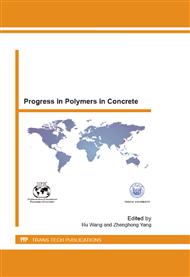p.88
p.94
p.100
p.107
p.112
p.118
p.124
p.130
p.136
Experimental Investigation on Mix Design and Mechanical Properties of Polymer (Latex) Modified Concrete
Abstract:
This paper presents the experimental investigation to enhance the mechanical properties of Polymer Modified Concrete (PMC) incorporating Styrene Butadiene Rubber (SBR) and describes the potential of using PMC as a structural material. PMC has been used for many years as an over layer in the bridges deck or for the repairing the defected concrete structures subjected to marine environment. But, because of low compressive strength due to foaming phenomenon, PMC has not been considered as a structural concrete. In this study, a range of investigations including sensitivity of PMC to water cement ratio, the effect of SBR proportion on compressive strength and modulus of rupture, selection of the proper antifoaming agent, the effect of various curing methods on compressive strength, proper mix design of PMC to achieve medium to high compressive strength are carried out. Also, the instructions for casting PMC are composed which can be stated as a standard for mixing and curing procedure of PMC. Results show that increasing the proportion of latex in PMC causes the strength reduction. But, using appropriate antifoaming agent (defoamer) and proper curing method, the mechanical properties can be recovered remarkably.
Info:
Periodical:
Pages:
112-117
Citation:
Online since:
April 2013
Authors:
Price:
Сopyright:
© 2013 Trans Tech Publications Ltd. All Rights Reserved
Share:
Citation:


